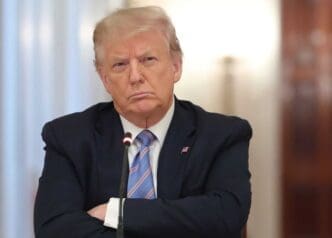President Donald Trump has eased back partially from the most extreme version of his trade policy. Just a week ago, he had proposed significant new tariffs on nearly all imports from most countries, a move that sent shockwaves through the business world and caused a stock market downturn. Many nations were facing tariffs exceeding 30 percent under these “reciprocal tariffs,” which Trump incorrectly claimed were equivalent to foreign trade barriers against American goods.
The policy led to a collapse in the stock market and disrupted many businesses reliant on foreign goods and parts. Despite the economic upheaval, Trump remained firm until Wednesday, the day the tariffs were to be enacted. In a post on Truth Social, he announced a reduction in the tariffs to 10 percent for all nations, except China, where a 125 percent tariff was imposed. This escalation in the trade war with China marked the climax of a week of retaliatory tariffs between the two economic powerhouses, effectively halting most trade between them. The S&P 500 experienced its largest rally in five years following Trump’s announcement, which was a positive sign for the US economy. However, the situation remains precarious. While the current plans appear moderate compared to the original proposals, they still represent a significant shift from pre-inauguration expectations, which considered a 10 percent universal tariff as a worst-case scenario.
Trump’s previous campaign promises included a 10 percent tariff on all foreign goods and a 60 percent tariff on Chinese imports, which was widely dismissed by investors as unrealistic. Trump’s trade strategy, described by future Treasury Secretary Scott Bessent as a “maximalist negotiating position,” now seems radical. The current tariffs, including those on Chinese goods and foreign cars, are anticipated to cost typical US households even more. Additional “sectoral” tariffs are expected to raise prices on items like lumber and pharmaceuticals. If these policies persist, economic pain is expected to increase.
Despite the recent stock market rally, the S&P 500 is still lower than it was in January, suggesting that investors are cautious about America’s growth prospects under current trade policies. The moderation of tariffs indicates a potential shift, but uncertainty remains. Trump’s recent actions could pave the way for tariff reductions, as negotiations with 75 countries are underway. However, his belief that the US should run a trade surplus with every country complicates negotiations, as trade balances are influenced by complex economic factors beyond governmental control.
While many countries are seeking talks with the United States, the Trump administration’s lack of response raises questions about its commitment to resolving trade issues. Even with genuine interest in negotiations, it’s unclear what concessions can be made by America’s major trade partners, who may not impose unfair tariffs on US products.
Ultimately, Trump’s trade policy has created uncertainty, which can hinder business investment and economic growth. While the US has stepped back from immediate disaster, the future direction of trade policy remains uncertain.
The Evolving Landscape
- The reduction in tariffs might provide temporary relief to businesses and stabilize market confidence, but long-term economic effects remain uncertain.
- Households may face increased costs due to persistent tariffs on Chinese goods and potential sector-specific tariffs, affecting everyday expenses.
- Uncertainty in the business environment may lead companies to delay investments, slowing economic growth and impacting job creation.
- Trump’s stance could influence international relations and future trade negotiations, affecting global economic dynamics.
- The potential for further tariff reductions offers hope for improved trade conditions, but the outcome remains unpredictable as negotiations progress.







